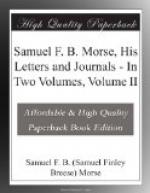Mr. Morton, answering this letter on May 22, informs Morse of his reelection as president of the National Academy of Design, and adds: “By the by, talking of coming back, do try and make your arrangements as soon as possible. We want you very much, if it is only to set us all right again. We begin to feel the want of our Head Man.”
Reverting to the journal again, we find this note: “March 3. For some days past I have been engaged in packing up and taking leave, and yesterday was introduced by the Count le Grice to Cardinal Weld, who received me very politely, presented me with a book, and sent me two letters of introduction to London.”
On March 4, Morse, with four companions, started from Rome on the seemingly perilous journey to Florence. They passed through the lines of both armies, but, contrary to their expectations, they were most courteously treated by the officers on both sides. It is true that they learned afterwards that they came near being arrested at Civita Castellana, where the Papal army was assembled in force, for—“When we took leave of the Marquis at Terni he told us that it was well we left Civita Castellana as we did, for an order for our arrest was making out, and in a few minutes more we should not have been allowed to leave the place. Indeed, when I think of the case, it was a surprising thing that we were allowed to go into all parts of the place, to see their position, to count their men and know their strength, and then to immediately pass over to their enemy and to give him, if we chose, all the information that any spy could have given.”
It is not within the province of this work to deal at length with the political movements of the times. As we have seen, Morse was fortunate in avoiding danger, and we learn from history that this revolt, which threatened at one time to become very serious, was eventually suppressed by the Papal arms aided by the Austrians.
Having passed safely through the zone of danger, they travelled on, and, on March 9:—
“At half-past three the beautiful city was seen to our left reposing in sunshine in the wide vale of the Arno. The Duomo and the Campanile were the most conspicuous objects. At half-past four we entered Florence and obtained rooms at the Leone Bianco in the Via Vigna Nuova.
“March 10. We found to-day, to our great discomfiture, that we are allowed by the police to stay but three days in the city. No entreaties through our consul, nor offers of guaranty on his part, availed to soften towards us the rigor of the decree, which they say applies to all foreigners. I have written to our consul at Leghorn to petition the Government for our stay, as Mr. Ombrosi, the United States Consul here, is not accredited by the Government.”
He must have succeeded in obtaining permission to remain, although the fact is not noted in the journal, for the next entry is on April 11, and finds him still in Florence. It begins: “Various engagements preventing my entering regularly in my journal every day’s events as they occurred, I have been compelled to make a gap, which I fill up from recollection.”




